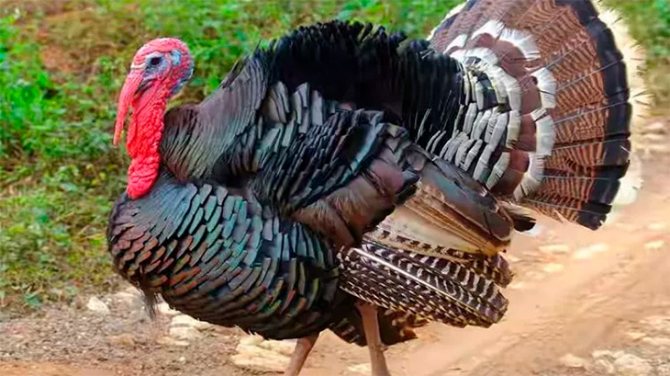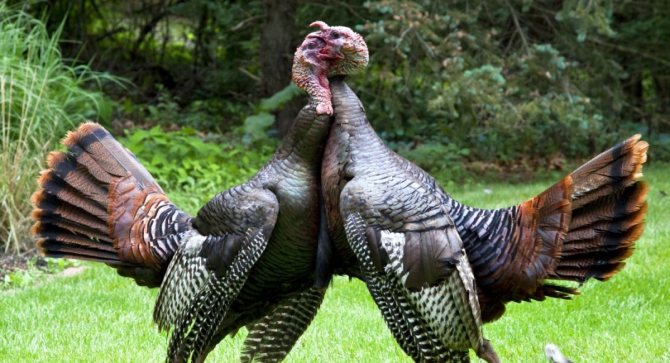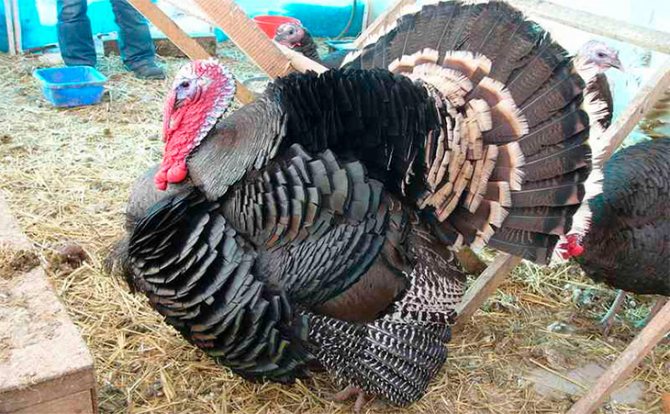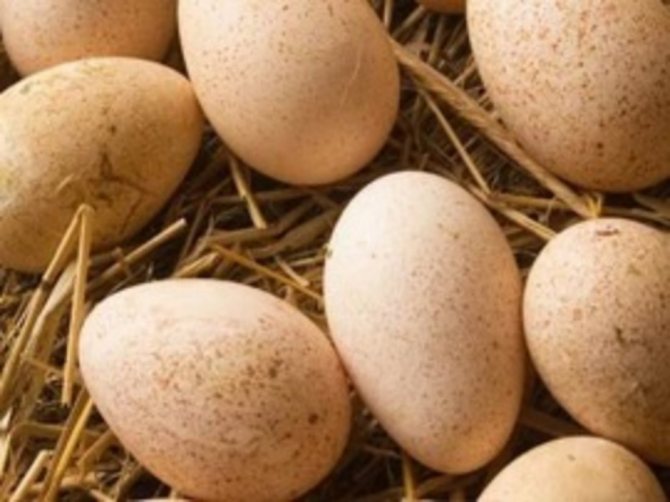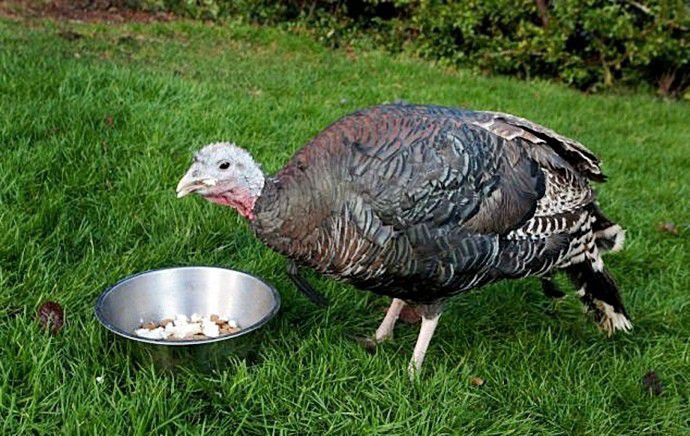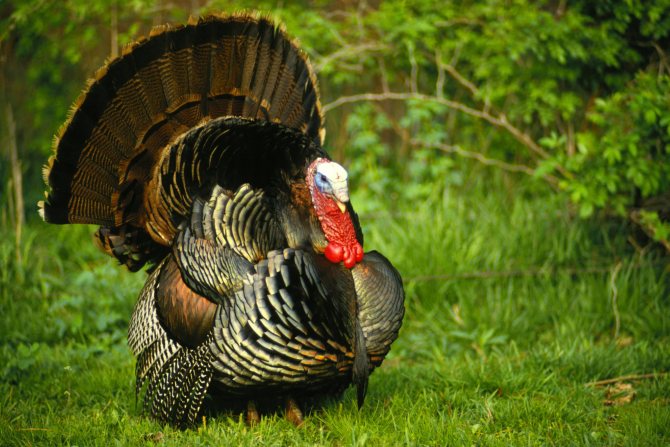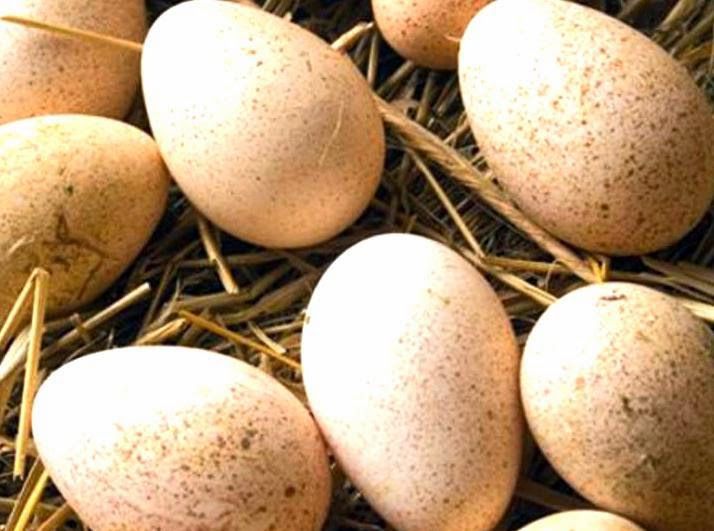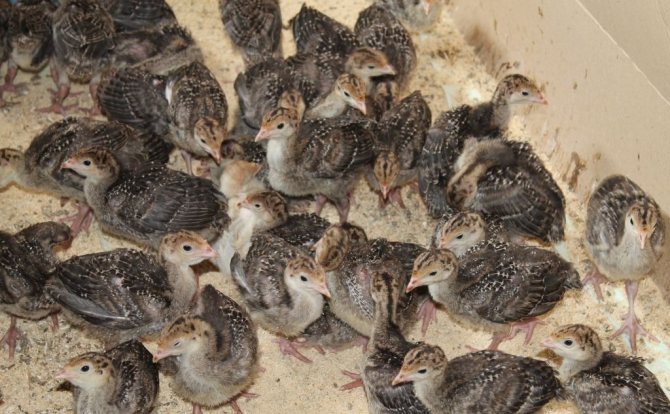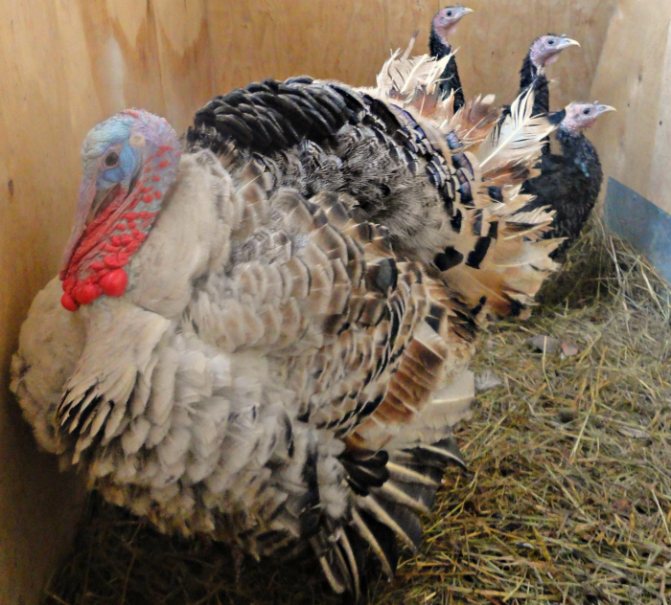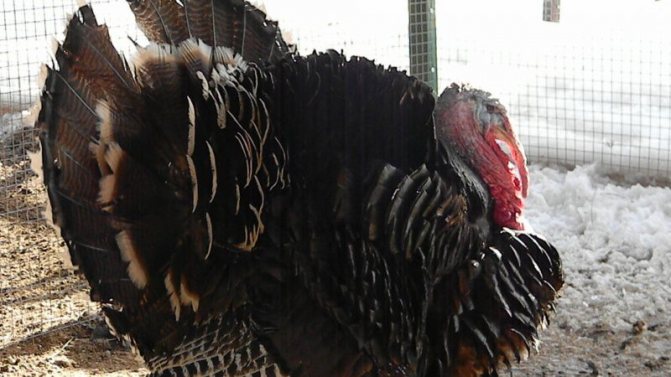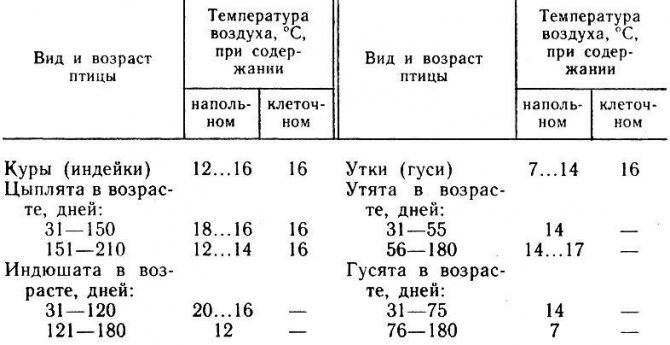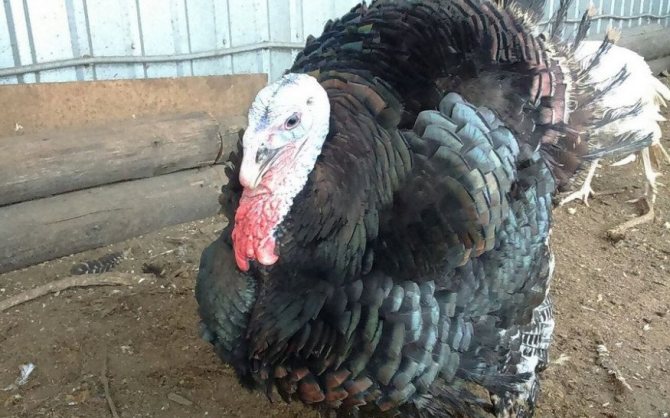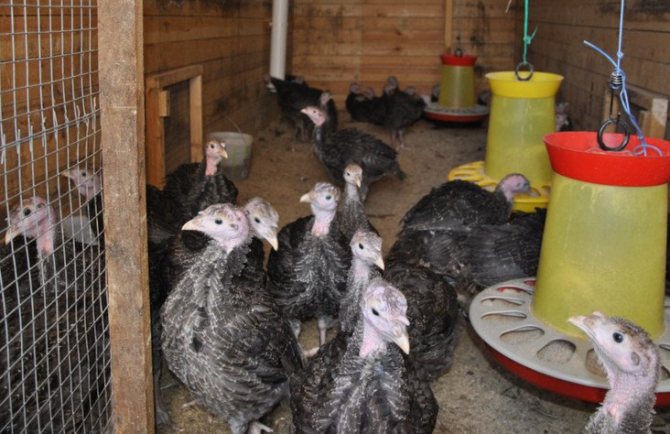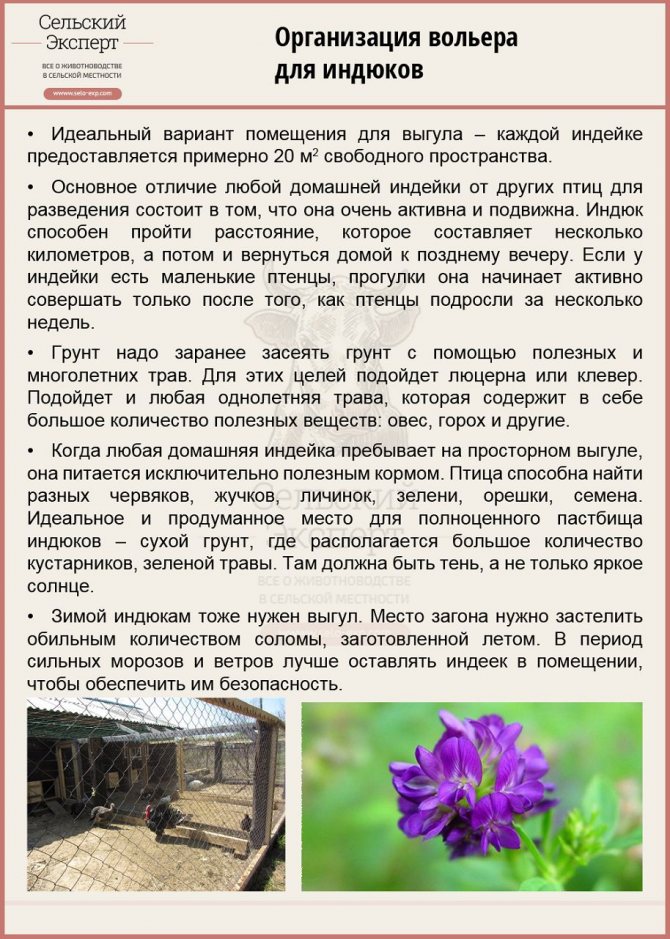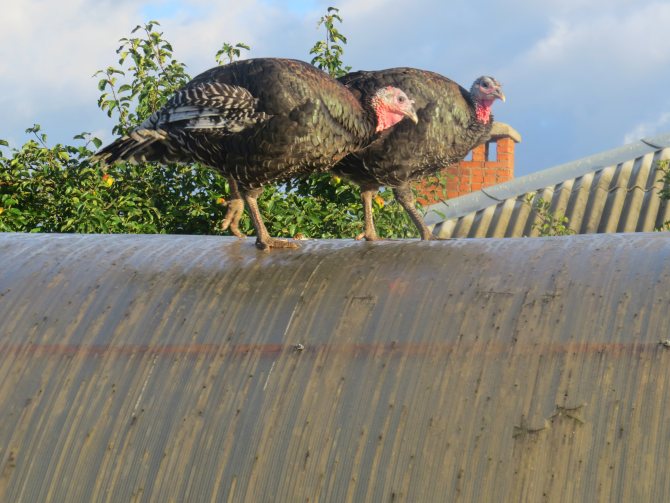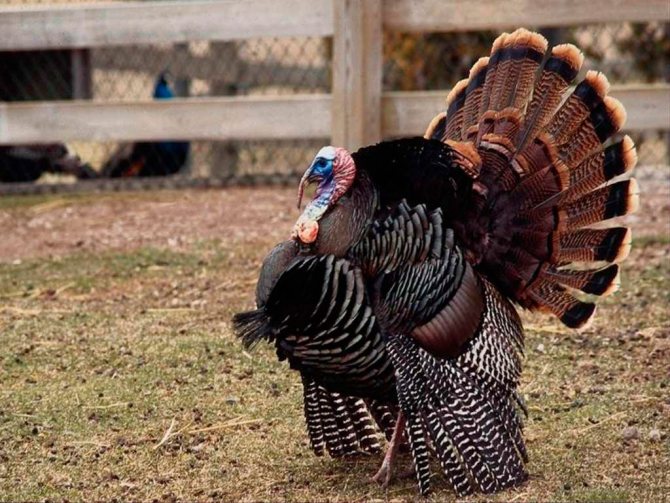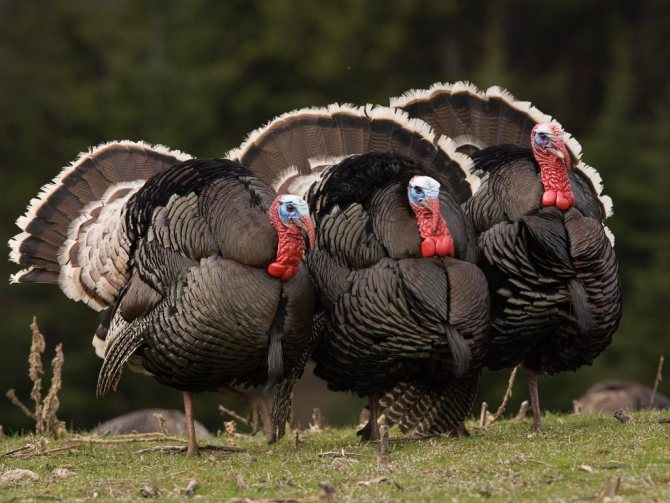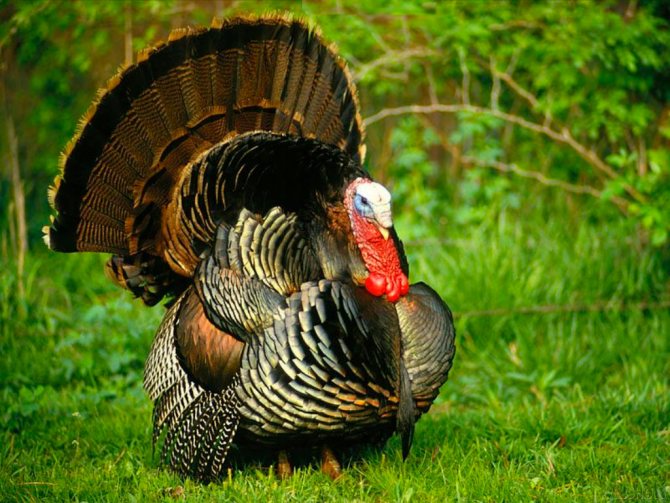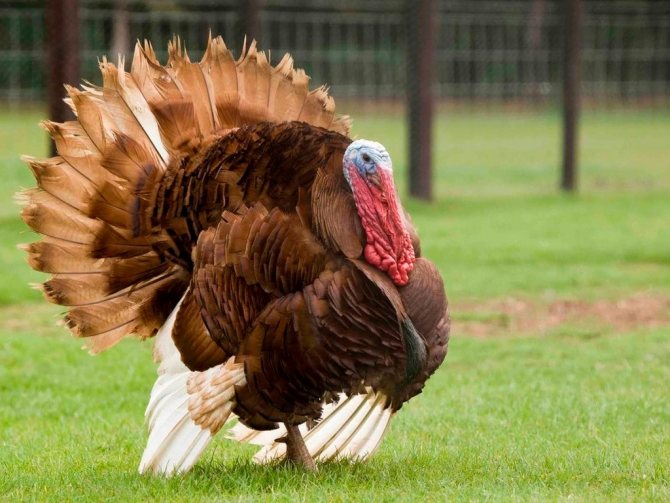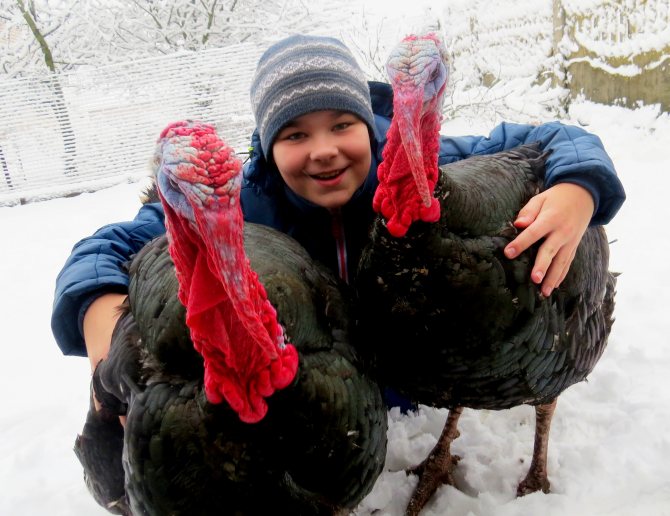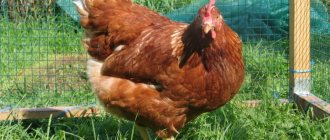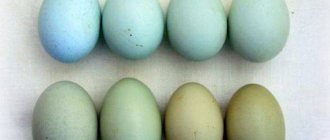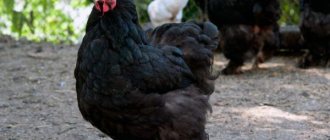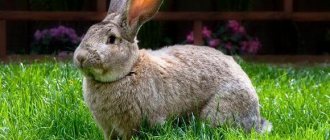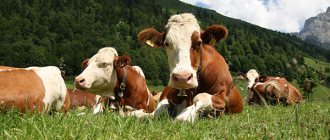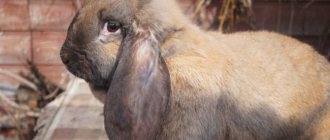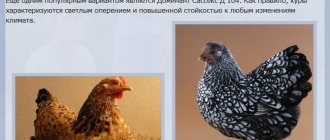»Poultry» Turkeys »Turkeys Bronze 708 - breed description
0
10
Article rating
The heavy and broad-chested Bronze 708 turkeys are quite popular with breeders. Representatives of this breed have a decorative appearance, good productivity and unpretentiousness. For such characteristics as delicious tender meat and high egg production they are rated "premium class". Consider the features of the cross, the rules of care and maintenance in the household.
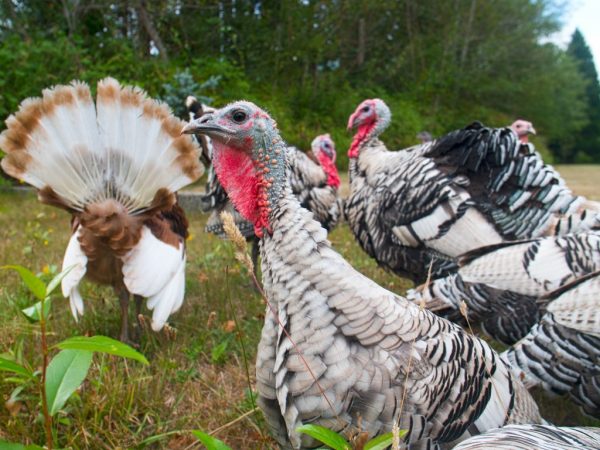
Turkeys Bronze 708 - breed description
External description
The main distinguishing feature of the cross is the bronze color of the feather with a greenish-golden tint. Turkeys have a placating nature, and males are prone to aggression.
The birds have an elongated body frame, they are broad-chested, with a short and hard beak. The skin on the head is wrinkled, pimply, blue in color. The neck is of medium length, gray in color. Legs are strong, stocky.
The external feature of turkeys is a short outgrowth above the beak, in turkeys it is much larger. Females are smaller in size, their live weight is 9 kg, males can reach 18 kg.
Turkey weighing 30 kg: the difficulties of growing at home
The turkey of mediums of heavy cross-country bronze 708 belongs to broilers. Of all turkeys of this type, it is the fastest growing, the largest individual weight can reach 30 kg.
A weight of 30 kg can be achieved by a turkey cross 780, but only if all the necessary requirements for this are met. And they are achieved, as a rule, only in industrial conditions.
Broiler turkeys cross bronze 708
On farms, the turkey is kept at a certain temperature, an artificially created microclimate system, specialized feed is used, saturated with various additives, and regular and constant monitoring of the birds is carried out. In fact, the poultry farm creates ideal greenhouse conditions.
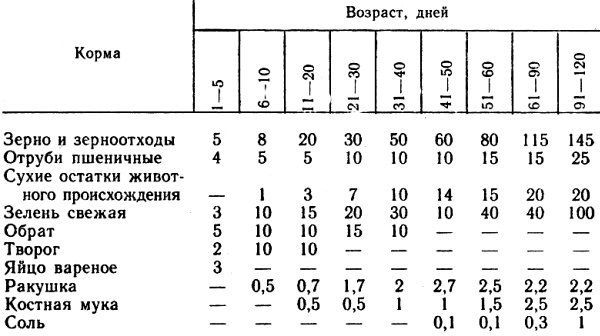

Turkey fattening diet
In the household, achieving this level of comfort is elusive, if at all realizable. So it turns out that crosses weighing 30 kg can only be grown on poultry farms.
Growing crosses at home is possible, but here you should focus more on the real numbers of weight gain by turkeys, 18 kg as a maximum. In addition, it is recommended to keep this type of bird in cages.
The optimal weight indicators of the Bronze 780 cross are 15-18 kg for an adult male and 8-9 kg for a mature female.
Performance
Females are slaughtered on day 150, when their weight reaches 8 kg. Males are slaughtered 160-170 days after hatching. By this age, their weight is 14 kg.
The characteristics of the breed include high productivity of turkeys from 1 to 4 years. They willingly hatch their own offspring, so there is no need to use an incubator. Some breeders give them the eggs of other birds to get a new brood.
Egg production rates are quite high - one female can lay from 75 to 140 eggs per year. From this amount, about 80% of fertilized eggs are obtained. The first clutch occurs at 10 weeks of life. The best brooders are considered to be two-year-old females.
The eggs are large: the average weight is from 85 to 100 g. The shell is light beige with dark brown spots on the surface.
A family
It is recommended to place bronze turkeys in the aviary.The family usually consists of one male and two females.
Simultaneous placement in one shed of two or more males threatens an unfavorable psychological situation and "turkey fights". Therefore, it is imperative to separate the turkeys.
Bronze turkey in an aviary
The best turkeys for reproduction are over a year old and under 3-4 years old. And good hens are two years old. At this age, they produce healthy turkeys.
Pros and cons
| pros | Minuses |
|
|
Description and characteristics of the breed
Representatives of this breed grow to very large sizes. Probably not a single bronze broad-breasted turkey that weighed less than nine kilograms.
Attention! Young individuals weigh about eleven kilograms on average, and adult birds weigh at least eighteen kilograms.
Experienced farmers claim that with abundant feeding and following the rules of care and reproduction, you can grow turkeys weighing up to thirty kilograms. Bronze turkeys have another name - "American". It reminds that the breed was bred in America.
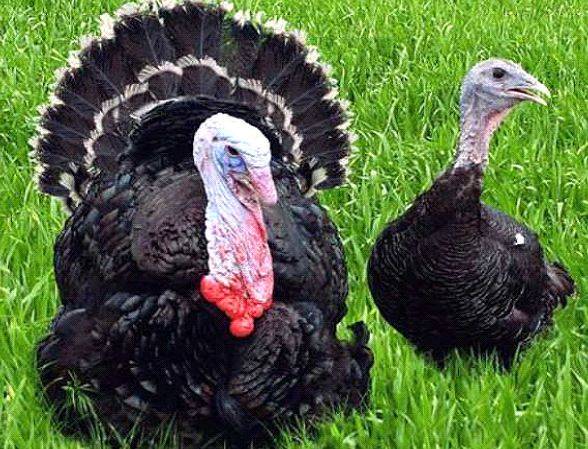

Important! This breed can be crossed with other, less fleshy breeds to improve performance and create new varieties of turkeys.
The body of these birds is oval, the chest is wide, convex and very strong. Graceful gait and powerful legs give the breed even more nobility. Bronze broad-breasted turkey has excellent plumage, black feathers shimmer in the sun with a bronze, purple and bluish tint. Bronze is the predominant color, as the name of the breed suggests. Males are distinguished by a fan-shaped gorgeous tail.
Food
Correct and balanced nutrition will provide the whole herd with good immunity against diseases and increase productivity.
Food for adults:
- Dry mixes (compound feed). They contain all the components necessary for growth and development.
- Wet mash. They are prepared from several ingredients - ground cereals, corn, grass, root crops, oilcake. Moisture is provided by the broth that is obtained by boiling the bones. You can also moisten the dry mixture with water. With this type of feeding, crushed cereals are additionally given - wheat, barley, oats or corn. They should make up 40% of the daily diet.
Also, cottage cheese, bone meal, fresh herbs, powdered eggshells, shells, wheat bran are mixed into the feed.


The feed must be balanced
In addition to the main food, the bird is given vital trace elements - sodium, phosphorus, potassium, as well as amino acids (cystine, lysine, arginine, histidine, tryptophan). They ensure the full growth and development of both adults and young animals.
In the winter season, with a lack of juicy and enriched with useful substances, sauerkraut, nettle, fortified flour based on needles are introduced into the diet.
In addition to properly selected food, clean and fresh drink must be provided. For water supply, it is better to use vacuum drinkers, through which dirt does not penetrate and the water always remains clean.
Chicks diet
- The first 6 days - give a chopped boiled egg. It can be mixed with low-fat cottage cheese. They feed every 2-2.5 hours.
- From day 7 - they give a mixture of finely chopped herbs, boiled eggs with the addition of cottage cheese. Additionally, add 10-15 g of boiled, grated potatoes, a little feed yeast, chopped peas. The frequency of feeding is 6-8 times a day. Turkey poults are very fond of green onions, which are served to them in the morning.
- From the 14th day - they stop giving eggs. The basis of food is crushed oats. It is poured with yogurt, skim milk or skim milk. The amount of greens is increased - 15-20 g per individual per day. Legumes are also mixed into feed - crushed peas and soybeans. They contribute to the full development of the musculoskeletal system in chicks.
- By the 30th day - exclude cottage cheese, leave only return for making wet mash. Crushed cereals, wheat bran, whole oats and barley are also provided.
- From 2 months - the chicks begin to gain muscle mass, therefore, chopped corn, meat and bone meal and sprouted grains are added to the diet. These components of the main compound feed are retained until the slaughter of the poultry.
- After 90 days, the composition of the feed remains unchanged, only the amount of its components is adjusted. One individual per day will require 150 g of green mixtures, 50 g of crushed meat, 20 g of meat and bone meal and wheat bran, 5 g of feed chalk and table salt. The frequency of feeding is 4 times a day.
From 4 months, young animals are transferred to the general diet of adults.
Prohibited foods
Birds are prohibited from giving expired, musty foods, fiber (up to a month), sticky cereals and mixtures, whole grains and poisonous plants (caustic buttercup, wild rosemary and hemlock).
Advantages of the breed
There are a lot of advantages of this breed over other types of turkeys. We will try to list the main advantages:
- high egg production. These turkeys differ in both quality and quantity of eggs. In one season, a turkey can demolish about 120 of them. Of these, 96 eggs can be fertilized, and of 67 small turkeys will hatch;
- maternal instincts. Turkeys of this breed are caring and attentive mothers. They incubate their offspring with great patience. Moreover, they can be planted on the eggs of other birds, such as chickens or ducks;
- early maturity. At the 20th week of life, bronze turkeys can weigh up to eight kilograms, and turkeys - at least fourteen kilograms;
- profitability. You do not need to feed these turkeys for a long time. They are usually slaughtered twenty weeks after birth. The reason is that after this age, birds need a lot more feed to maintain their weight, and even more so in order to further build muscle mass.
Important! Up to twenty weeks, turkeys consume one and a half kilograms of feed per kilogram of body weight per day.


Conditions of detention
To breed this breed, you will need to equip a good room in which the turkeys will feel comfortable. One individual needs at least 1 m² of the total area.
In order to avoid hypothermia and the appearance of various infections in the turkey house, a stable temperature regime should be ensured - within 20 ° C. In frosty weather - not lower than 5 ° С.
It is also important to avoid drafts, to which birds are very sensitive. The house must be well ventilated. It is provided by ajar windows.
The optimal duration of a light day is at least 10 hours a day.
- There is plenty of natural light during the warmer months.
- In winter, the hen house is supplemented with lamps.
An important role is played by high-quality and thick bedding made of hay, sawdust or straw - 15-20 cm. It must be dry and must be replaced at least once every six months.
Drinking bowls and feeders
Turkeys drink a lot of water, so there should be a sufficient number of drinkers in the aviary or turkey house.Nipple water supply systems are installed for chicks. Three weeks after birth, they are transferred to drip or vacuum type drinkers.
In order to provide the herd with fresh feed and variety, it is necessary to install several types of feeders. The first solid is suitable for filling with everyday food. The second, consisting of sections, is designed to bookmark vitamins, minerals and other useful additives.
Additionally, one or more wide, but not deep containers filled with sand or ash are installed in the room. Regular dry baths will help poultry avoid infestation with various parasites - lice, chewing lice, etc.
Nests and perches
The best place to install them is in the darkest and most secluded corners of the house. This will allow the turkeys to hatch their eggs without worry.
Usually, for laying hens, nests are arranged in the form of a box with an open top and a bottom covered with straw or hay.
The perches are placed at a height of 40-50 cm, the warmest place in the chicken coop is selected.
Walking place


There must be one male in the aviary
A small area is suitable for walking, since this bird belongs to broiler breeds and an active lifestyle prevents rapid weight gain. For one individual, 1 m² of the total area is enough.
The walking area is sown with grass, sprinkled with shells. Drinking bowls, feeders and a basin with sand or ash for bathing are also installed.
When kept in an aviary, two females and one male are populated.
Remember! Do not keep several males in the same room. This can lead to bloody fights and the death of weaker individuals.
Disadvantages of bronze broad-chested turkeys
Bronze broad-breasted turkey feels great in the conditions of industrial breeding of birds for slaughtering meat. Compared to smaller domestic breeds, breeding wide-breasted broilers is more costly for the farmer. It is necessary not only to purchase costly feed, but also vitamin complexes.
Mineral complexes help to maintain the general tone of individuals and serve as preventive measures against viral diseases. Cash costs are justified by the large volume of meat product obtained at the output.
Breeding
For this breed, two methods of breeding new offspring are used, each giving a positive result.
Incubation
To get healthy and strong chicks, you need to select high-quality and fresh eggs. Each specimen should be carefully examined under an ovoscope. When viewed under this device, the yolk should move smoothly and slowly. The optimum age of the material for laying in the incubator is 6-7 days.
The second stage of preparation is heating the eggs to 20 ° C. Heat gradually so that no condensation forms on the surface. Then they are placed in an apparatus equipped with automatic egg turning.
It is important that the incubator has a stable temperature and humidity.
Under optimal conditions, chicks will hatch in 27-28 days. After drying, they are placed in cardboard boxes. The temperature is set in the range of 29-30 ° C and good lighting is provided with artificial light lamps.
Natural method
Many breeders practice hatching turkey poults naturally. For this, turkeys with a calm character and a pronounced incubation instinct are selected. 15-17 eggs are laid under one hen.
After a week, the eggs are examined under an ovoscope, the unfertilized ones are removed and disposed of. On day 26, specimens with frozen embryos are removed. Chicks are collected as they hatch from day 27-28, after they have completely dried out.
Turkey poults that cannot get out of the egg on their own need help - gently break off the shell at the place of pecking.
The next day, the chicks can be added to the hen. She will take good care of them for 1-1.5 months.
Features of incubation and care of turkeys
Turkeys are wonderful mothers, but naturally a large number of poultry cannot be quickly obtained. You will need to hatch turkeys in an incubator. To do this, you should choose the best eggs: the correct shape, not too large and not small, with a smooth, beautiful shell without sagging and outgrowths.
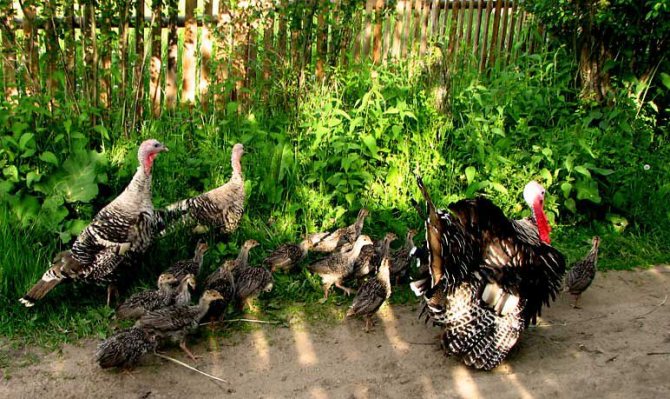

Female turkeys are good mothers
Ovoscope prices
Ovoscope
How to incubate bronze turkey eggs
The embryos of turkeys develop on average 28 days. If the eggs are incubated correctly, then most of the chicks will be born after this time.
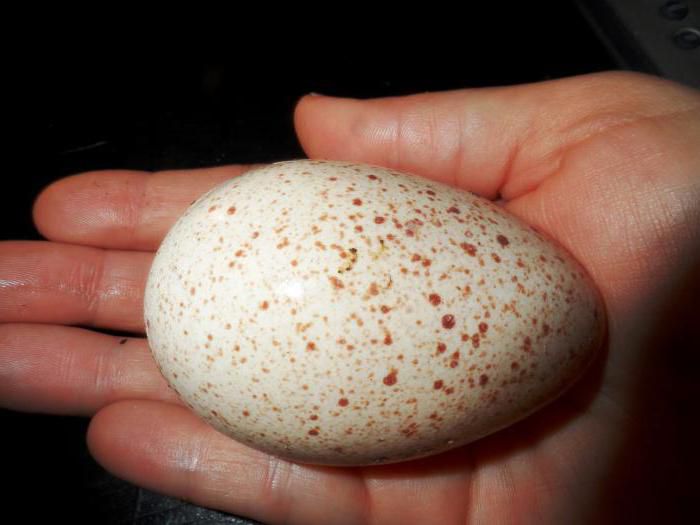

Hatching egg of cross turkeys Bronze 708
What indicators need to be considered in the process?
| Day | Number of turns | Humidity,% | Temperature, degrees Celsius |
| 1–8 | 4–12 | 60–65 | 37,5–38,1 |
| 9–14 | 6 | 45–50 | 37,6–38 |
| 15–8 | 4 | 65 | 37,5 |
After 25 days, you no longer need to turn the eggs - the chicks begin to hatch. To make this process easier, you need to lower the temperature to 37 degrees, and increase the humidity to 70 percent.
Those who are engaged in incubation for the first time should use the step-by-step instructions.
Step 1. We check the eggs for quality with an ovoscope. With this translucent equipment, you need to carefully examine the yolk. It should be located exactly in the center, and when the testicle rotates, move extremely slowly.


Ovoscope translucent egg
Step 2. We warm up the testicles to 18-20 degrees so that condensation does not form.
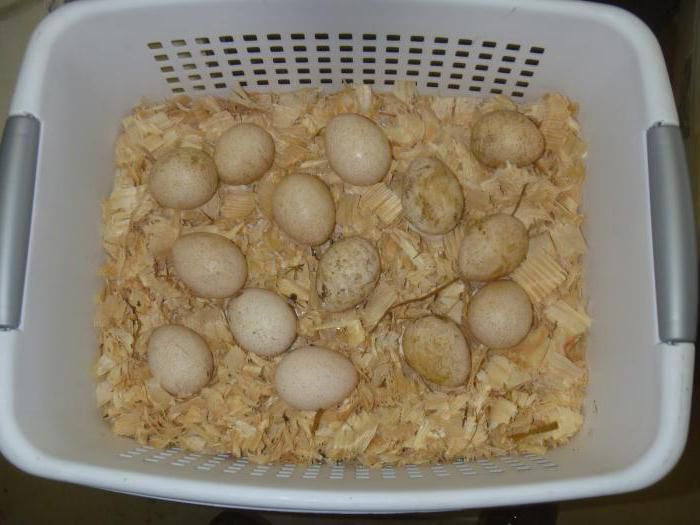

Warm up before laying eggs.
Step 3. We fill the incubator. If your equipment automatically turns eggs, they are placed vertically and the gaps are filled with flexible polyurethane foam. Manual mode assumes horizontal laying of eggs.


Setting eggs in the incubator depends on the type of equipment
Step 4. We make marks on the testicles so as not to confuse later which one was turned and which one was not. Usually these are the letters "B" and "D", denoting evening and day.


If you are turning eggs by hand, be sure to take notes.
Step 5. We maintain the temperature and humidity in the equipment, make the required number of turns daily, according to the table above. Automatic incubators perform all these functions themselves. Do not forget to add water to the trays installed at the bottom of the device. This is necessary to maintain sufficient humidity.
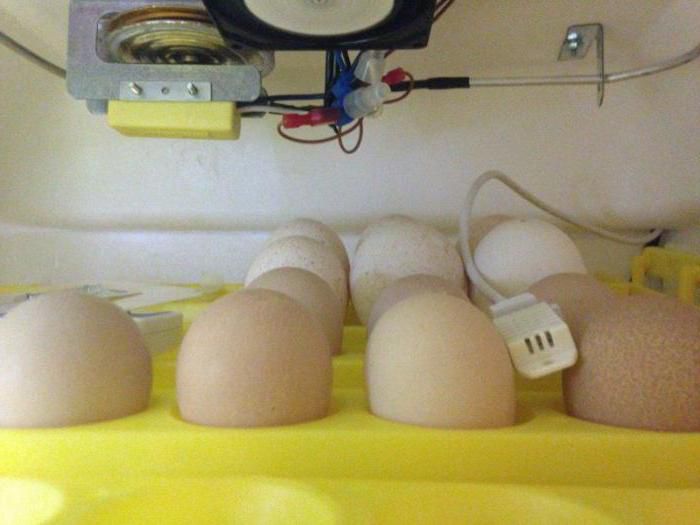

Eggs in an incubator
Step 6. On the eighth day, each egg is again translucent with an ovoscope. You can already see the embryo and remove unfertilized and dead eggs. If the embryo is not viable, a bloody ring will be visible in the yolk.
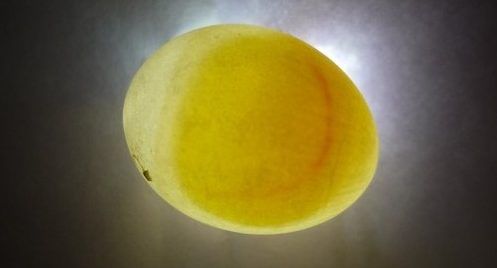

"Blood ring" when the egg is seen through an ovoscope
Be sure to check that there are no power outages. For safety reasons, it is worth connecting an additional power source, for example, from a car battery. If this is not the case, and the electricity is gone, you need to open the ventilation doors so that the embryos do not suffocate.
After hatching and transplanting the chicks, the shells are removed and the device is washed. Boiled and crushed shells can be fed to poultry.
If eggs are not bought at poultry farms, then it will not be possible to collect them in the household immediately in the required amount. Some of them will have to be stored until the required number appears. This is done at twelve degrees of heat for no longer than ten days to preserve a living embryo.
Egg incubators prices
Egg incubators
What to do when chicks hatch
Newly appeared chicks should be allowed to dry slightly, and then moved to a specially designated box. It should be located in a room where the temperature is at least 30 degrees Celsius.
When the babies are fluffy, they are introduced to the expectant mother. 780 turkeys have such a strong maternity instinct that they will accept any babies.
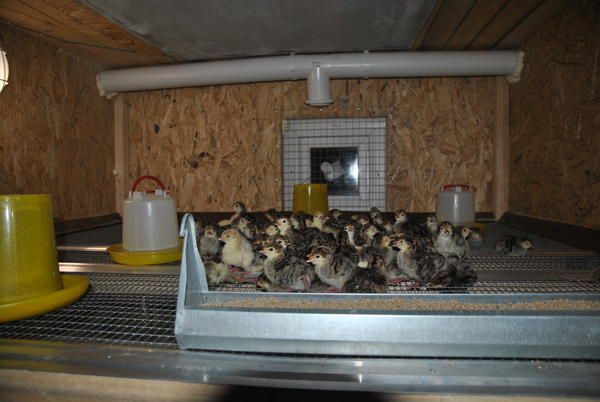

Chicks of turkeys of Bronze 708 breed
If there are no suitable females, the owners of the poultry house themselves will have to take care of the chicks.This is not an easy occupation: the crumbs should be kept in practically greenhouse conditions.
It is required to exclude drafts, but at the same time the air should not be damp and stagnant.
Fence off a special area in the young animal enclosure. For twenty crumbs, five square meters are needed, and when they are a month old, the area should be doubled. By this time, they will have acquired feathers, only a little cannon will remain on the heads.
If there is no desire to independently engage in breeding, you can purchase ready-made chicks. The cost of bronze 708 turkey poults is on average 250 rubles per day-old chick plus five rubles for each additional feeding day.
Prices for a brooder - a cage for growing chickens
Chicken brooder
Diseases
Turkeys are prone to various diseases, especially if the conditions of feeding, care and maintenance are violated.
- Infectious - mycoplasmosis, tuberculosis, pullorosis, histomonosis, Newcastle disease.
- Non-infectious - enteritis, vitamin deficiency, hard and saggy goiter.
Subject to all the rules of keeping, infection is extremely rare. Therefore, breeders are advised to carry out preventive measures:
- before settling in the young, carry out a disinfectant cleaning of the chicken coop;
- provide the necessary conditions - temperature, lighting, ventilation, humidity and avoid drafts;
- regularly clean the feeders, drinkers, change the old litter to a fresh one;
- at the first symptoms of the development of the disease, isolate the infected individuals in a separate aviary;
- vaccinate chicks at an early age.
Reviews of poultry farmers about cross Bronze 708
Not a bad cross with its pluses and minuses. Of the minuses: 1) It is difficult to move (I do not exclude that due to an error in incubation, but not a fact) 2) There are black stumps on the carcass that you need to try to remove. 3) Visual assessment is moderate in food. I could not calculate, since the bird was kept with other breeds of turkey. From the pros: I hammered a turkey 4.5 months old. Carcass weight without skin 12 kg. The weight seems to be mediocre, BUT not a drop of fat (in comparison with the Hybrid Converter) and, most importantly, very thin skin even on the chest and neck. It seemed to me that my light sneakers had thicker skin. Unfortunately, this time I didn’t pluck. hurried and skinned completely with feathers.
The numbers are as follows: 1) The weight of the gutted carcass without legs and skin - 11.5 - 12 kg (hung with a steelyard, possibly +/- half a kilo) 2) Breast (weighed separately) - 4 kg 3) Legs - 3.5 kg 4) Wings + Neck - 2 kg 5) Meat skeleton - 2.5 kg
Turkeys of the Bronze 708 cross are an excellent option for breeding on farms and personal plots. They are calm, unpretentious and more than pay off all the costs that were spent on their maintenance.
> Turkey Bronze 708 (bronze broad-breasted)
Testimonials
The Bronze 708 turkey breed is popular among breeders and has many positive reviews:
- chicks are distinguished by good survival rate and gain weight quickly;
- turkeys are valued for a long and high egg production, as well as a pronounced instinct for hatching young offspring, which allows you to independently get chicks without using an incubator;
- subject to all the rules of care, feeding and maintenance, birds rarely get sick;
- dietary meat has high taste and useful properties.
Purebred bronze turkeys and hybrids
The description of the breed of bronze broad-breasted turkeys always contains the term "premium class", which speaks of their undoubted merits, and the name is associated with a beautiful ebb of feathers and a massive physique. It was created in the United States by crossing wild individuals and an English black turkey. UK breeders continued with the Orlopp Bronze line. And on its basis, their French colleagues bred medium-heavy cross turkeys bronze 708.
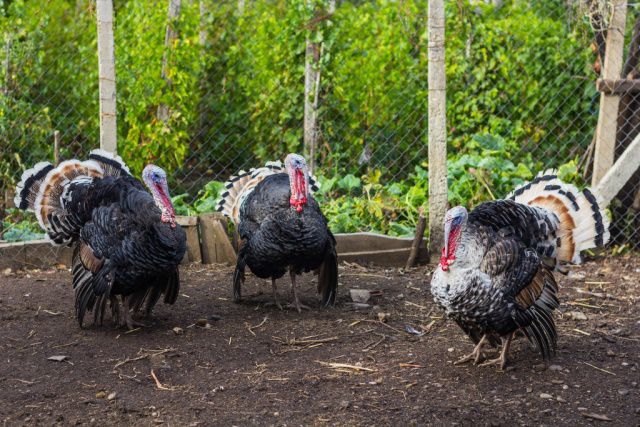

Bronze-708 turkeys are distinguished by their beautiful plumage and massive physique
What is the difference between cross and breed
For those who decide to start breeding turkeys, it is important to understand the difference between breed and cross. The breed unites birds with common hereditary characteristics: constitution and body weight, color, egg production, disease resistance, behavioral characteristics.
If birds of the same breed are crossed, their offspring inherit all the qualities of their parents. But when working with crosses, such a result is not obtained. Here, the parents are originally hybrids obtained by crossing. During reproduction, their offspring will differ in other characteristics, degenerate and become smaller.


Turkeys Bronze-708 is a cross
What is inbreeding
This term refers to closely related crossbreeding between animals of the same breed. It is necessary to consolidate the best hereditary qualities in poultry. The ideal option is considered to cross the offspring first with one of the parents, and the next stage - with the offspring from the previous crossing.
With prolonged imbreeding, the reproductive ability of birds decreases.
Therefore, it is better to mate inbred birds with representatives of other lines or to refresh the blood by buying males of the same breed from another herd.
Birds of the Bronze 780 cross are incapable of maintaining parental qualities by closely related crossing: they were bred to quickly obtain meat and eggs at a minimum cost. Turkey poults can come out with completely different characteristics. Breeders advise to mate this type of turkey with purebred to improve the performance of the cross.
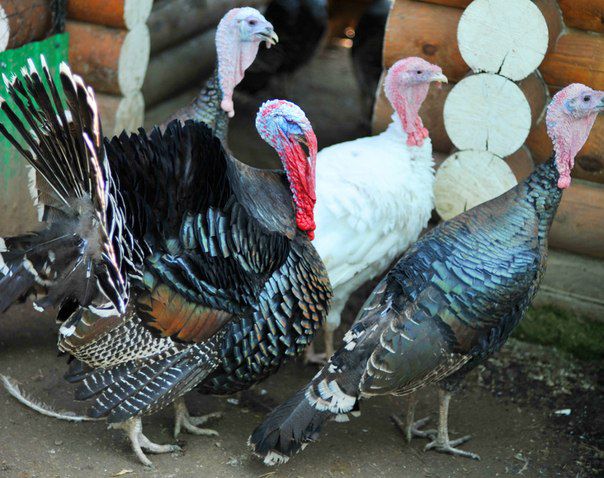

Bronze-708 turkeys are not suitable for inbreeding
Breeds of turkeys bred on the basis of a bronze broad-breasted
The broad-breasted turkey breed with cast bronze plumage is used to create new hybrids. Already now, on its basis, in addition to the 708 cross, such breeds have been bred as:
- beltsville;
- North Caucasian bronze;
- Moscow bronze;
- grelvitskaya.
But, compared to other options for broiler turkeys, it is the 708 that receives the most positive reviews from breeders.
Video - Bronze turkeys of heavy crosses
Diet for feeding cross-country
The bird is gaining weight quickly
Turkeys of this type are prone to rapid weight gain, however, for this they need to eat high-calorie foods. Usually, for feeding the cross, various compound feeds based on grain crops are used. Experienced farmers make individual bird feed, but there are also ready-made mixtures.
A balanced diet should contain a complex of vitamins and minerals. Without them, the growth of the bird slows down, and the level of health drops rapidly. Vitamin supplements include:
- fish fat;
- cake;
- bone flour.
In order to properly feed the cross in winter, you should prepare some ingredients in advance. Among them are:
- mixed grass hay;
- sauerkraut;
- herbal flour;
- a mixture of nettle, alfalfa and colza.
For better assimilation of the feed, chalk, gravel and small shell rock are added to the feeder.
To improve the egg production of turkeys, the amount of compound feed is reduced in the diet and fresh herbs and vegetables are added. Also, to increase calcium in the body, carrying females need to be given dairy products. Otherwise, the egg will be fragile and watery. There is a table of the required daily intake of minerals and vitamins, which should be consulted by inexperienced breeders.
The daily ration of the average cross 708 looks like this:
- Compound feed - 80 grams.
- Oat bran - 50 grams.
- Animal waste - 100 grams.
- Pure grain - 250 grams.
- Vegetable products - 50 grams.
- Shell rock, salt and bone meal - 25 grams.
For fattening boilers, the daily grain rate must be increased. At 4 months, one boiler eats two kilograms of feed.
Some breeders claim that special blends can be replaced with more common counterparts.For example, compound feed for pigs is also characterized by a high calorie content, and very often carrying turkeys, which have already lost their egg production, are transferred to this feed. This allows the bird to gain the required weight in the shortest possible time. The average weight of carrying females is from 5 to 8 kg, but with the help of proper fattening, this figure can be brought to 9, sometimes up to 15 kg of pure meat.
Breeding males and females, on the contrary, try to keep on a strict diet, since excess weight reduces the reproductive capacity of the animal body.
The feeding schedule must be strictly observed, otherwise the crosses will become nervous and lose weight due to stress. In addition, hunger has a bad effect on the character of turkeys - their level of aggression increases and birds begin to pose a danger to other individuals.
The best feeding of birds is provided by the hopper type of feeders. In this case, the minimum amount of feed is scrapped, and the turkeys themselves eat as much as they want. In addition, this feeding method requires minimal effort on the part of the farmer and is suitable for large, semi-automated farms.

